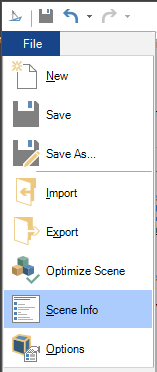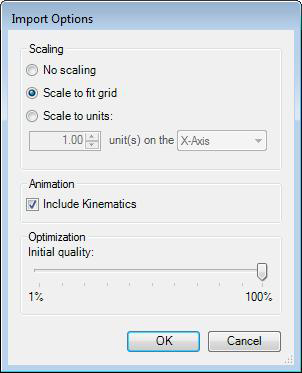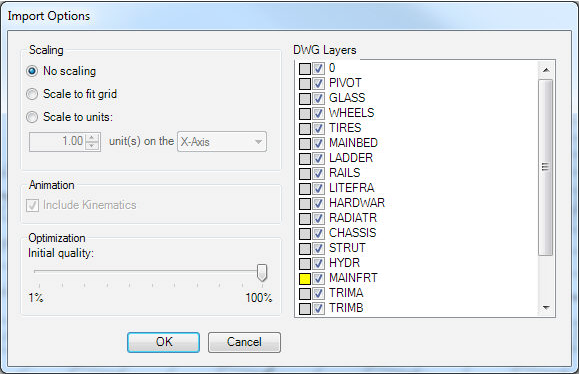Importing and Exporting 3D Models, Clipart, and GraphWorX Art
With GraphWorX64, you can import 3D models, clipart, and objects from other GraphWorX64 displays and templates. You can import models and clipart for use in both the 2D and 3D realms of GraphWorX64. And because GraphWorX displays are saved in XAML format, you can even import a GraphWorX display in order to pull in the objects that are in that display.
For example, it is likely you will import a majority of your 3D models from files created using other tools. Roughly 90% of the graphics formats that are available on the market can be imported directly into GraphWorX64, or converted to XAML and then imported.
|

|
Warning. A model that is created in a high-fidelity CAD program typically contains details, such as nuts and bolts, that are not necessary for use in real-time applications such as GraphWorX64. Such details typically are not monitored, their inclusion in a GraphWorX display does not provide feedback to the operator and, in most cases, there is no advantage to including them in a display. It is important to eliminate these unneeded details wherever possible because they add to the number of polygons in a model, which can become a burden for the graphics card and can slow the runtime performance of GraphWorX64. For this reason, before you export any model or clipart or object:
-
Review it and look at the number of polygons contained in it
-
Eliminate all details that will not have a use in the GraphWorX64 display you are creating. It is critical that you eliminate any details that are not required for the real-time context in the display.
-
Use the Polygon Reduction tool to further reduce its details; refer to the Reducing Polygons in 3D Models topic.
|
This topic describes the following steps:
Importing Graphics Files
GraphWorX64 comes with a free importer for the following file formats:
-
3DS (3D Studio, a royalty-free and prolifically-used tool).
-
XAML (Extensible Application Markup Language).
-
DAE (Digital Asset Exchange, a COLLADA file typically used for 3D clipart) specifications 1.4.1 and 1.5.0 -- All revolute joints are automatically transformed into GraphWorX64 rotation dynamics and prismatic joints are transformed into location dynamics
-
OBJ files
-
BIM (Building Information Modeling)
-
gbXML (An indusry supported schema intended for sharing building information between different building design software tools)
-
All GraphWorX display file formats
NOTE: Imported image files in the .psd format cannot be opened. It is recommended that users update the source project (from where the images will be imported) to contain common image formats (e.g., .jpg, .png, .gif, .bmp, etc.).
To Import a File:
- Click on the
 button in the Home tab of the ribbon. The cursor becomes a crosshair.
button in the Home tab of the ribbon. The cursor becomes a crosshair.
- Click anywhere in the GraphWorX64 display and drag to a desired size for the 3D space.
- Click the orange File menu tab .
File menu in 3D GraphWorX64

- Select Import and in the Open dialog box navigate to and select the file (*.xaml, *.3ds, *.dae, *.obj) you are importing.
- The dialog, as shown below, appears. You can use the default settings or customize it if needed.
Import Options

NOTE: You can leave the import options as is. Most of the options are self-explanatory. The last option, Kinematics, allows you to import the object with already added pick action, if the object or part of the object allows for movement.
- Save the imported model as a GraphWorX64 display (extension *.gdfx). (For a list of all valid file extensions, refer to the Displays and Templates topic.)
- When the GraphWorX64 display is saved, you can start to work with the object itself. Double-click the 3D View and you will see the result.
NOTE: An imported model can be un-grouped. If you want to group the objects to one Group, select all the objects you want to have included and click the “Group objects” icon, which is available in the ribbon.
No additional external software or tools are needed in order to import XAML or 3DS files. Any model that is created in XAML or 3DS format can be imported into GraphWorX64 for use in a 2D or 3D displays.
The 3D viewport has selection modes that can let you select an entire object or a facet of an object, for a more refined (although advanced) means for manipulating smart symbols and other objects. For more information, refer to Selection Mode Section of the 3D Home Ribbon.
Autodesk Import/Export
Importing/Exporting *.dwg and *.dxf Files
*.dwg files (Autodesk drawing files) and *.dwx files (Autodesk data exchange format) can be directly imported into GraphWorX64 3D Viewer without being converted. To import a file:
- Click on the
 button in the Home tab of the ribbon. The cursor becomes a crosshair.
button in the Home tab of the ribbon. The cursor becomes a crosshair.
- Click anywhere in the GraphWorX64 display and drag to a desired size for the 3D space.
- Click the orange File menu tab .
File menu in 3D GraphWorX64

- Select Import and in the Open dialog box navigate to and select the file (*.dwg, *.dxf) you are importing.
- The dialog, as shown below, appears. You can use the default settings or customize it if needed.
Import Options

Scaling options allow the user to determine how or if the object will be adjusted to size. For Autodesk files, Kinematics are automatically included during the import. The Initial Quality scale allows the user to modify the level of detail imported. For Autodesk files, it is highly recommended that the user sets the Initial Quality to 100% The DWG Layers menu allows the user to select which layers they wish to be included in the import. By default, all layers are included.
- Save the imported model as a GraphWorX64 display (extension *.gdfx). (For a list of all valid file extensions, refer to the Displays and Templates topic.)
- When the GraphWorX64 display is saved, you can start to work with the object itself. Double-click the 3D View and you will see the result.
The object can now be manipulated the same as any other GraphWorX object.
To Export an Autodesk File:
-
Be sure an object in your 3D view is selected.
-
Click the orange File menu tab .
![]()
 button in the Home tab of the ribbon. The cursor becomes a crosshair.
button in the Home tab of the ribbon. The cursor becomes a crosshair.